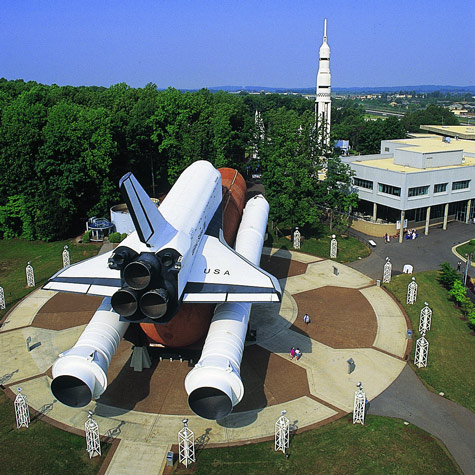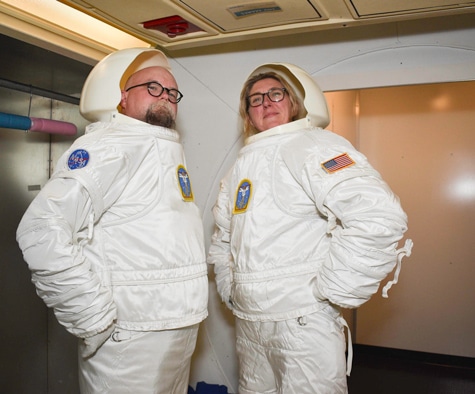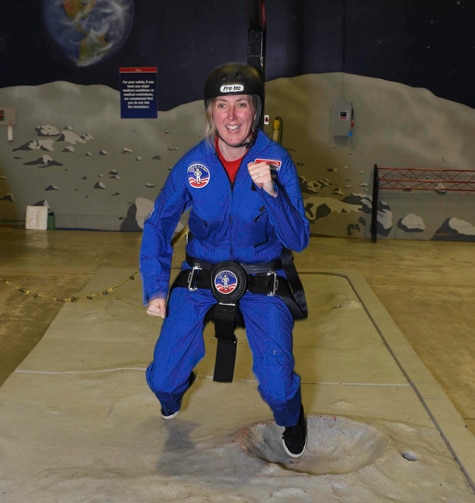Space fan and mum of three, Tracey Davies, relives the summer of ’69 at Space Camp, Alabama
“Ground Control to Major Tom,” I growl into the intercom in Mission Control. “Commencing countdown, engines on…” I prepare to launch into full Bowie when Sarah, my crew leader, rolls her eyes (she’s heard it all before) and reminds me that as CAPCOM (capsule communicator) I’m actually in charge of landing the space shuttle.
Straightening my NASA-blue flight suit, I consult the manual, flick a few important switches and land the shuttle like a boss. High-fiving my colleagues in Team Pioneer; a historian, a sci-fi writer and an opera singer, I realise I’ve missed my calling in life and despite being a forty-something mother of three, seriously consider retraining as an astronaut. Well, if Sandra Bullock can rock a space suit, so can I.

Tracey does her best space salute at the U.S. Space and Rocket Centre, Huntville

Captain Tracey lands the Space Shuttle
Welcome to Space Camp, aNASA-approved ‘astronaut training’ weekend for the space curious at the U.S. Space & Rocket Center in Huntsville, Alabama. Founded in 1982 as an educational camp for kids to promote STEM subjects, Space Camp has seen more than 800,000 cadets graduate, including 10 that went on to be astronauts, one of which is currently working on the International Space Station (ISS). Alongside kids’ camps, family and adult Space Camps are also held on select weekends throughout the year.
I’ve been a space geek for as long as I can remember. And while I wasn’t born when man first landed on the moon fifty years ago on 20th July 1969, I did grow up during the space era and was obsessed with rockets, spacemen and the moon – forget popstars, I had posters of hunky astronauts plastered across my bedroom wall.

Team Pioneer at rocket launch
While many think of Houston and Florida as the pulse of NASA, America’s space programme actually started here in Huntsville, Alabama in 1958, when Dr Wernher von Braun, a German rocket scientist and pioneer of space exploration, became the first director of NASA at the Marshall Space Flight Center. Still NASA’s largest rocket research centre, it’s currently developing the new Space Launch System (SLS), an advanced launch rocket which will fly us back to the moon and eventually beyond to Mars.
The museum opened in 1970 as NASA’s first visitor centre and features an extensive collection of cool rocketry include Pathfinder, the first Space Shuttle (actually built of wood and steel to test the facilities) and one of the original Saturn V rockets, designed by von Braun of which its successor launched Apollo 11 on its epic voyage in 1969.

Get up close to the real thing at Huntsville Space and Rocket Centre, Alabama

Tracey looking the part in mission control
For the three-day residential camp, I’m in Team Pioneer and allocated a dorm in Habitat 1 with fellow space fanatic, Michelle from Dublin. The basic, windowless pods are designed to simulate the compact quarters on the ISS with hard bunks, communal showers and a strict no booze rule (boo). Family cadets also stay on-site and can share dorms with other families.
Days start early with a communal breakfast at 7.30am and we’re kept busy until lights out at 10pm. All meals are included and eaten together in the crew galley, although sadly it’s more school dinners than cool freeze-dried space food.
The weekend is largely centred around our two space missions with rocketry workshops, team-building exercises and simulator rides factored in. As official Space Camp cadets, we also have full run of the museum, including after-hours, which is how I found myself mooning over Armstrong’s actual space suit late one night in the ‘Apollo: When We Went to the Moon’ exhibition.
On the same campus is the Davidson Center for Space Exploration, a vast rocket hanger which displays a Saturn V test rocket and other Apollo memorabilia, including the training lunar module that Armstrong, Aldrin and Collins trained in before the 1969 mission, which I’m allowed to giddily sit in.

Tracey and Captain Barney show off their space suits

Tracey does the moon walk
Sadly, I don’t get to wallow in zero gravity while I’m here (an experience which costs around £4k a pop). The closest I get is a bounce on the 1/6th micro-gravity chair, which uses a hydraulic system to simulate how it would feel to walk on the moon. I also take a spin on the multi-axis trainer, a cross-section of steel hoops which prepares astronauts for any uncontrollable spins in space. “Don’t worry,” explains Sarah. “Your stomach sits at the centre of gravity, so keep your eyes open and you won’t feel sick or dizzy.” And sure enough, after spinning like a spindle for two minutes, I survived and it was almost fun.
At Sunday’s graduation, I proudly step up on stage to receive my official space wings, following in the hallowed footsteps of the 10 graduates who have gone on to become astronauts. Space Camp was the first step for them, maybe it could be a giant leap to a new career for this old mum.
How to get there?
Delta flies from Heathrow to Huntsville, via Atlanta, from £690 return. The three-day camp is Friday until Sunday and includes all meals and accommodation. Family Space Camps start from £730 for an adult and child, and £268 for additional family members, while Adult Space Academy starts from £415.
Best for:
Space geeks with children aged seven or over.
Best time to go:
With the 50thanniversary of the moon landings in July, this summer is the best time to go. Although July and August gets hot in Alabama, most activities are inside air-conditioned classrooms and museum. Check out more information on Huntsville or Alabama